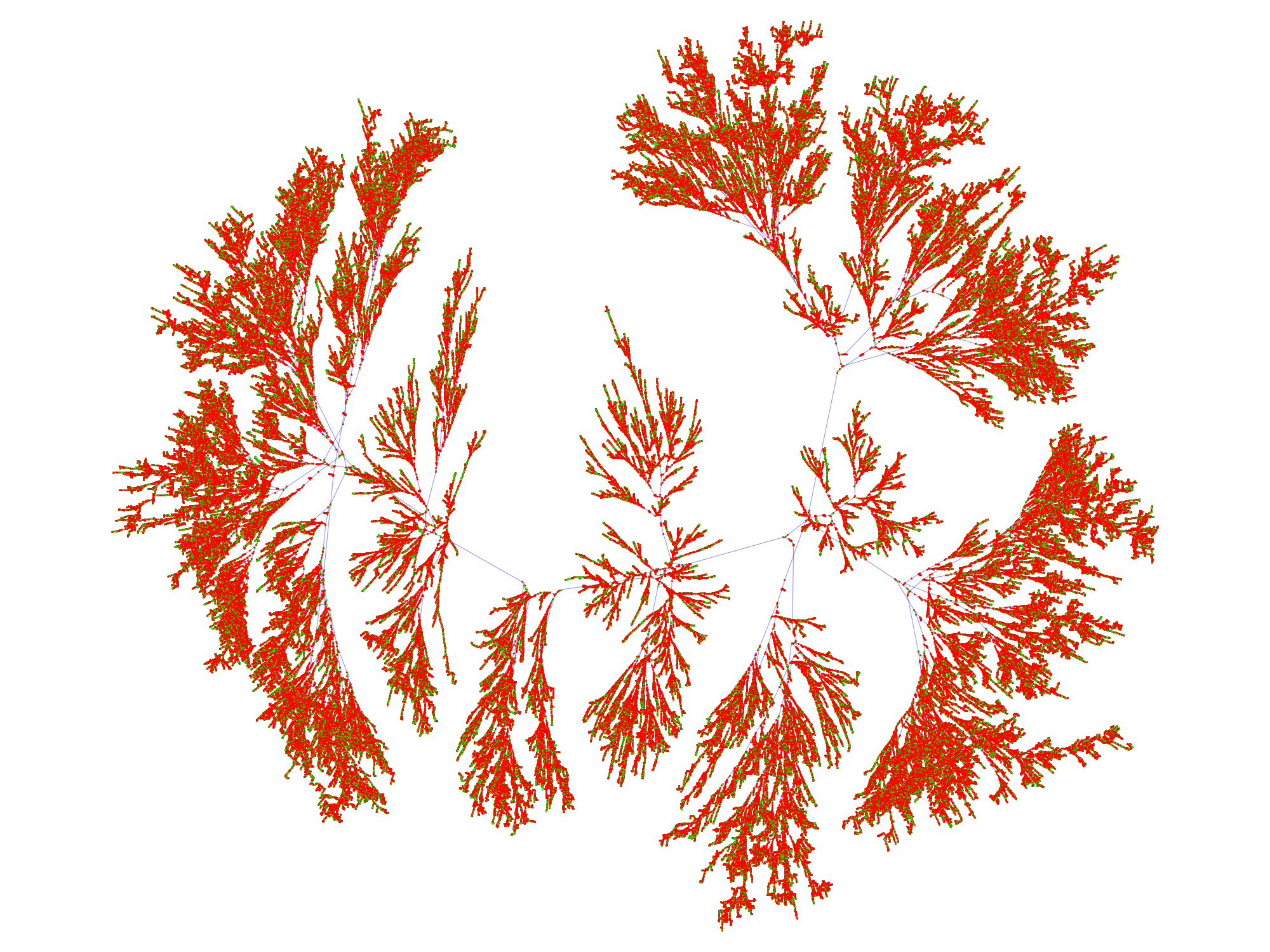I'm interested in generating and rendering extremely large graphs, i.e., ones having $10^6 \to 10^8$ vertices. (These graphs will ultimately be rendered in PDF or PNG and printed on large, poster-sized paper.) Although the code may work for small graphs, there are inevitably limitations for large graphs due to computer memory (especially when embedding or laying-out the graph, as we'll see).
Consider the small graph generated by the Collatz conjecture with 400000 nodes (see code below, based on the cited problem):
where the GraphLayout -> {"PackingLayout" -> "ClosestPacking"}. This can be computed directly on a Mac laptop. But for larger numbers of vertices, the graph cannot be rendered.
Note especially that this is just a representative graph... I need a solution for many different large graphs, ones without simple geometric structure.
The problem arises when one wants to generate and lay out (or "embed") $10^7$ vertices. The problem is not so much the computation of the vertices and edges (which can be done by writing to a large external file), but instead laying out the graph. The Layout nominally needs all the vertexes in active memory in order to perform the layout, and that is impossible on most machines.
[I've closed all other applications to provide Mathematica with the maximum memory, but even this is not enough for the large graphs I wish to render. Perhaps this entire problem is solved by moving the enormous computation to the Wolfram Cloud... and if this is the case, I guess I'll merely purchase an account and run my code there. But I'm hoping there is a better way... one that can be used on laptops and desktop machines (with large hard memories).]
One might try to layout portions of the overall graph and then "glue" them together, but the local optimization of layout of each portion is likely not appropriate for the full graph: Different branches will ultimately overlap, breaking the rule of the global optimization routine.
My idea is to generate the enormous graph $G$ (but not lay it out). Then select some small random subset of the vertexes, $V_1$, say 1% of those in $G$, to form a smaller, representative graph $G_1$ where the edges in $G_1$ are estimates of the "distance" between each vertex based on their step separation in $G$. Then, layout this representative $G_1$ (which should be no problem because it is small). Then, anchor the vertexes of $G_1$ in place in the final layout and then render all the vertexes of $G$. In this way, the full, final graph $G$ is rendered appropriately, and the memory constraints are not exceeded.
Perhaps there is a way to extract VertexCoordinates and iteratively layout vertices in regions, hopping through the overall graph. (This seems extremely inefficient.)
Or use smart memory management... or another technique.
CollatzSequence[list_] :=
Module[{memory, tmp, chain, result = Internal`Bag[]},
memory[1] = False;
memory[n_] := (memory[n] = False; True);
Do[chain = Internal`Bag[];
tmp = l;
While[memory[tmp], Internal`StuffBag[chain, tmp];
tmp = If[EvenQ[tmp], tmp/2, 3 tmp + 1];];
Internal`StuffBag[chain, tmp];
Internal`StuffBag[result, chain], {l, list}];
Internal`BagPart[#, All] & /@ Internal`BagPart[result, All]];
myCollatzGraph = Rasterize[
Graph[Flatten[(Rule @@@ Partition[#, 2, 1]) & /@
CollatzSequence[Range[400000]]],
GraphLayout -> {"PackingLayout" -> "ClosestPacking"},
VertexStyle -> Opacity[0.2, RGBColor[.9, .1, .1]],
EdgeStyle -> RGBColor[.1, .1, .9],
ImageSize -> 2000],
ImageResolution -> 72];




IGSmoothenfrom IGraph/M, which replaced chains of edges as in1->2->3->4->5... with a single weighted edge1->5. This would reduce the size of the graph by 5-6 fold, and the weights can be used to maintain the layout. However, I noticed thatIGSmoothenis currently not fast enough. I will look into optimizing it. It should work much faster on graphs of this size. $\endgroup$Deleteis slow. I will fix this for the next release (due tonight). $\endgroup$a -> b, b-> c, etc.) to external files and then link these up. This might require some cleverness in finding the tree structure, but that is an algorithmic (not processing) problem. So that portion of the work can be done. As far as I can see, the layout (embedding) is the subproblem that is hard to perform in Mathematica. Might analogous large problems have been mapped to memory architectures? Will this work in the Wolfram cloud? $\endgroup$